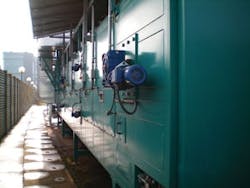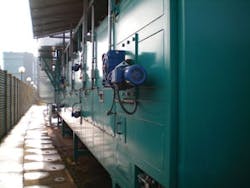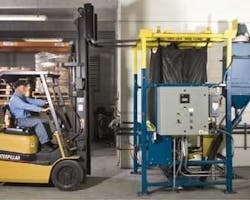By Adam Willwerth
With the rising cost of energy, the use of variable frequency drives is growing. By optimizing electrical flow to an alternating-current (AC) motor, a VFD can provide substantial energy savings. But if the efficiency is not sustainable, those savings vanish.
Currents induced on motor shafts by VFDs can wreak havoc with motor bearings, dramatically shortening motor life and causing costly repairs, even in many motors marketed as "inverter-ready." To mitigate these currents and realize the full potential of VFDs, a reliable method of shaft grounding is essential.
Pitting of a bearing race wall at regular intervals leads to a phenomenon called fluting.
While a number of shaft-grounding technologies exist, they vary in effectiveness. One new system is designed to last the life of the motor. Engineered with special conductive microfibers, the Aegis™ shaft grounding ring from Electro Static Technology redirects shaft currents from shaft to frame (ground), bypassing the motor's bearings.
Bearing Damage
Serious electrical bearing damage can be attributed to high peak voltages and extremely fast voltage rise times associated with the high switching frequencies of modern VFDs. The higher the carrier frequency, the higher the discharge rate.
From its first minute of operation, a VFD induces voltages that build up on the motor shaft until they find discharge paths to the frame (ground). In most cases, the motor bearings present the path of least resistance. Once voltage is sufficient to overcome the resistance of the oil film layer in the bearing, shaft current discharges, causing electrical discharge machining (EDM) pits and fusion craters in the race wall and ball bearings.
Discharges through bearings can be so frequent that before long the entire bearing race wall becomes riddled with fusion craters known as frosting.
Since many of today's motors have sealed bearings to keep out dirt and other contaminants, electrical damage has become the most common cause of bearing failure in VFD-controlled AC motors.
In the phenomenon known as fluting, the operational frequency of the VFD causes concentrated pitting at regular intervals along the race wall, forming washboard-like ridges. Fluting can cause excessive noise and vibration, and by that time, bearing failure is imminent.
Short of dismantling the motor, there are two main ways to check for bearing damage –– measuring vibration and measuring voltage. Neither method is foolproof. By the time vibration tests confirm bearing damage, it is usually far advanced. Likewise, the main benefit of voltage tests may be the relief they provide if the results indicate no bearing damage. If a baseline voltage measurement is taken right after a VFD has been installed, subsequent monitoring may provide early warning of harmful current loops, but there are many variables.
The AEGIS™ SGR Bearing Protection Ring
Shaft currents can be measured by touching an oscilloscope probe to the shaft while the motor is running. These voltages repeatedly build up on the rotor to a certain threshold, then discharge in short bursts along the path of least resistance, which all too often runs through the motor's bearings.
The Aegis™ SGR Bearing Protection Ring is designed to redirect shaft currents along a low-impedance path from shaft to ground. The system is available in two versions –– a continuous ring that can be installed with either brackets or conductive epoxy and a split ring for field installations. Unlike conventional shaft grounding brushes, the ring's conductive microfibers work with virtually no friction or wear and are unaffected by dirt, grease, or other contaminants.
About the Author:
Adam Willwerth is Development Manager for Electro Static Technology, Mechanic Falls, ME. For more information on the system, visit www.est-aegis.com.
More WaterWorld Current Issue Articles
More WaterWorld Archives Issue Articles





